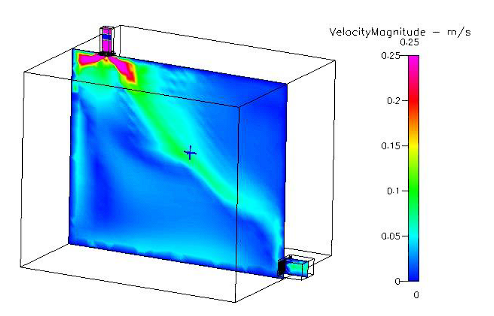Airborne Infection Isolation Room with Low-Cost Operating System
doi: 10.14456/mijet.2023.2
Keywords:
Airborne infection isolation room, COVID-19, Low-cost operating system, PID controlAbstract
The objective of this work is to develop an airborne infection isolation room (AIIR) with the air control system. The commercial sensors and the proportional integral derivative (PID) control were used in the control system. All sensors were calibrated before use for the system. User interface was developed by using LabVIEW. Key parameter for design of the control system was capability of pressure reduction, i.e. -2.5 Pa. Flow distribution in the AIIR with the variation of outlet position at 10, 60 and 100 cm height was also analyzed to find proper position. From design and development of the system, the tests showed that from the start of operation, the system with PID control decreased room pressure to each setpoint, i.e. -2.5, -4 and -6 Pa, in 15 seconds and maintained the pressure at the setpoint with stability. The outlet at 10 cm height showed low level of air dispersion and turbulence, while 60 cm height provided back flow and high dispersion of air.
References
"International cooperation for the coronavirus combat results, lessons, and Way Ahead," http://pl.chinaembassy.gov.cn/pol/zt/FNCV/202003/t20200310_2370533.htm (accessed Jul. 07, 2022).
J. K. Lee and H. W. Jeong, "Rapid expansion of temporary, reliable airborne-infection isolation rooms with negative air machines for critical COVID-19 patients, " Am. J. Infect. Control, vol. 48, no. 7, pp. 822–824, Jul. 2020, doi: 10.1016/j.ajic.2020.04.022.
B. desu, L. Tilahun, and M. Zeleke, "Preparedness of governmental hospitals for COVID 19 prevention and care in Eastern Amhara region, Amhara Ethiopia, 2020," Heart Lung, pp. S0147956322001509, Jun. 2022, doi: 10.1016/j.hrtlng.2022.06.017.
K. Skok et al., "COVID-19 autopsies: Procedure, technical aspects and cause of fatal course. Experiences from a single-center," Pathol. - Res. Pract., vol. 217, pp. 153305, Jan. 2021, doi: 10.1016/j.prp.2020.153305.
F. Ventura, A. Molinelli, and R. Barranco, "COVID-19-related deaths in residential care homes for elderly: The situation in Italy," J. Forensic Leg. Med., vol. 80, pp. 102179, May 2021, doi: 10.1016/j.jflm.2021.102179.
A. Golcuk, "Design and implementation of a hybrid FLC + PID controller for pressure control of sleep devices, " Biomed. Signal Process. Control, vol. 76, pp. 103702, Jul. 2022, doi: 10.1016/j.bspc.2022.103702.
S. Li, M. Wei, Y. Wei, Z. Wu, X. Han, and R. Yang, "A fractional order PID controller using MACOA for indoor temperature in air-conditioning room," J. Build. Eng., vol. 44, pp. 103295, Dec. 2021, doi: 10.1016/j.jobe.2021.103295.
A. Ferrari, A. Mittica, P. Pizzo, and Z. Jin, "PID Controller Modelling and Optimization in Cr Systems with Standard and Reduced Accumulators," Int. J. Automot. Technol., vol. 19, no. 5, pp. 771–781, Oct. 2018, doi: 10.1007/s12239-018-0074-4.
T.-Y. Guo, L.-S. Lu, S.-Y. Lin, and C. Hwang, "Design of maximum-stability PID controllers for LTI systems based on a stabilizing-set construction method," J. Taiwan Inst. Chem. Eng., vol. 135, pp. 104366, Jun. 2022, doi: 10.1016/j.jtice.2022.104366.
J. Liu and G. X. Wang, "The Optimization of Adaptive PID Control Algorithm Based on RBF Neural Network," Adv. Mater. Res., vol. 998–999, pp. 943–946, Jul. 2014, doi: 10.4028/www.scientific.net/AMR.998-999.943.
Ming-guang Zhang, Xing-gui Wang, and Man-qiang Liu, "Adaptive PID control based on RBF neural network identification," in 17th IEEE International Conference on Tools with Artificial Intelligence (ICTAI’05), Hong Kong, China, 2005, p. 3 pp.683. doi: 10.1109/ICTAI.2005.26.
A. Mersha et al., "Health professionals practice and associated factors towards precautionary measures for COVID-19 pandemic in public health facilities of Gamo zone, southern Ethiopia: A cross-sectional study," PLOS ONE, vol. 16, no. 3, pp. e0248272, Mar. 2021, doi: 10.1371/journal.pone.0248272.
Manop Rakyat et al., "Study of air distribution in tray dryer using computational fluid dynamics," Eng. Appl. Sci. Res., vol. 48, pp. 684693, 2021, doi: 10.14456/EASR.2021.69.

Downloads
Published
How to Cite
Issue
Section
License

This work is licensed under a Creative Commons Attribution-NonCommercial-NoDerivatives 4.0 International License.








